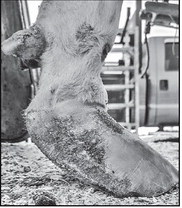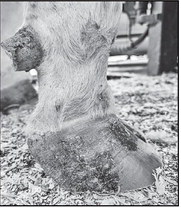Brubacker


Continued from page 12
much, won’t ruminate as much, and produce as much milk. So, hoof health is very important,” said Steven.
He considers himself part of an animal health team, including the veterinarian, nutritionist, and herdsman, who are all working to achieve the best health outcomes for the dairy cattle.
In order to be the best trimmer he can be, Steven has taken advantage of several educational opportunities. He attended Midwestern Hoof Trimming School, which is a weeklong course which dives into the internal components of the hoof structure.
There are two schools in Wisconsin — in Baraboo and Green Bay. Steven completed his schooling back around 2016 or 2017. He also attends annual professional conferences of the Hoof Trimmers Association, which includes members from 38 U.S. states, nine Canadian provinces, and more than 15 countries.
These conferences give him the opportunity to network with other hoof trimmers from across the country and world.
“I’m always looking for ways to improve foot health in general,” he said. “There has been some real good improvement made over the last several years. Researchers are always doing new studies and learning more about hoof care. You can never know everything; you always want to keep learning.”
Although he enjoys the job and finds it rewarding, Steven also recognizes the job comes with inherent challenges, not the least of which is the risk of injury that comes with working with large animals and power tools.
“You’ve got to be really careful. A lot of people in the business have lost fingers because the cow flinched a little bit,” said Steven.
The hoof trimmer also never knows exactly how the cow will behave, as it’s an animal with a mind of its own.
“There are challenges every day, working with difficult cows.... You try to keep kicks at a minimum, but it does happen still. It’s a challenge working with animals,” he said. “If they get you in a comer, or you turn around in a tight spot, you can get crushed pretty easily. You gotta watch their legs; you don’t want to get kicked.”
“I’ve actually been really lucky,” he added. “I’ve never really had a serious injury. The worst injury I had from a cow kicking me would be soon after I started trimming: a cow had kicked me and it put my back out of place. But it’s something I just deal with. It’s one of the risks that comes with working with bigger animals like that.”
The job also takes a physical toll due to the repetitive nature of the movements.
“A lot of older trimmers will develop caipal tunnel or different aches and pains, especially wrist pain,” said Steven.
For now, though, Steven is content with his job and plans to continue offering this crucial service to local farms. He finds satisfaction in doing a good quality job.
“I enjoy being outside eveiy day. And, there’s definitely an art to being a good hoof trimmer. You’re working with pretty slim margins. The more experienced you are, the more precise you can be. But that’s what I like about the job. I’m kind of a perfectionist; I like things just right. So it’s satisfying to be able to take a hoof and make improvements so they will balance better and walk better.”
Steven resides near Riplinger with his wife Carolyn, and their daughter, Marina, 1.5 years old.
For more information on Brubacker’s Hoof Care, call Steven at 715-316-8209. If he is not available, feel free to leave a message and he’ll return your call.
BEFORE AND AFTER - The picture at left shows a cow’s hoof before it has been trimmed by Steven Brubacker, while the one on the right shows a freshly shaved hoof. Cows need to have their hooves trimmed two or three times a year in order to stay healthy and comfortable.
SUBMITTED PHOTOS

